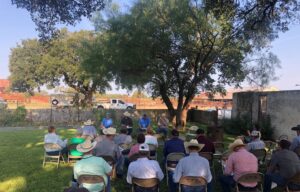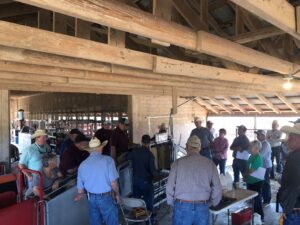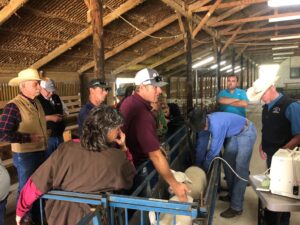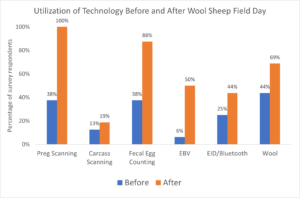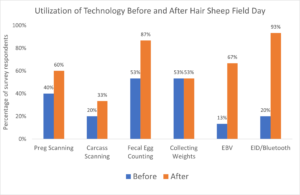Final report for ES19-147
Project Information
Texas is the largest sheep and goat producing state in the U.S., but parasite infestations and poor lamb crop percentages have plagued the state industry. Producers using estimated breeding values from the National Sheep Improvement Program have improved parasite resistance and fecundity in several other states, but the Texas seedstock industry has been slow to adopt the use of this genetic selection tool. To increase the utilization of this technology we trained county agents and mentor sheep and goat ranchers to use EBV technology and be ambassadors for the widespread implementation of this technology in both traditional and nontraditional sheep and goat rearing areas of Texas. Initially, we hosted a workshop for county agents and mentor ranchers to demonstrate how the program works and provide hands-on experiential learning. Then, specialists, agents and ranchers toured farms and ranches in other states that have successfully used EBVs for 10 or more years. Thereafter, agents and ranchers implemented this technology on their ranches within their counties. Lastly, agents and ranchers served as hosts for field days, attended by over 100 regional sheep and goat producers. Quantitative genetic selection can rapidly advance the genetic resistance of sheep and goats to internal parasites, which will reduce or eliminate the need for pharmaceutical anthelmintics. It can also improve the reproductive efficiency of sheep and goats to allow producers to supply the growing demand for Texas grown lamb, wool, goat meat, and mohair. Neither of these goals can be met without continued use of this technology.
- Texas A&M AgriLife Extension Agent understanding of how EBVs are developed by sheep and goat seedstock suppliers and why it is important that commercial producers buy rams/bucks with EBVs;
- Development of mentor ranchers that will implement quantitative genetic selection strategies and serve as leaders within the seedstock community;
- Widespread awareness in sheep and goat industry of EBVs and why it is important that they are used in flock/herd replacement selection.
Genetic technologies are key to increasing production efficiency and animal health in the United States sheep industry. Specifically, quantitative genetic selection with estimated breeding values from the National Sheep Improvement Program are a valuable tool for improving hard-to-measure traits, such as reproduction, parasite resistance and carcass quality. This technology is underutilized by the Texas seedstock sheep industry, a region where lamb crop percentages are significantly lower than the national average (79% vs 107%) according to the USDA National Agriculture Statistics Service. Poor genetic propensity and reduced animal performance due to parasitic infection are two of the causes for poor lamb production and survival. Greater adoption of EBV can be part of the solution for addressing these challenges, however the necessary management changes to implement EBV technology on a sheep or goat operation are not always intuitive. Through this project we aimed to train county extension agents and mentor ranchers in the processes of data collection and management, selection of sheep with EBV, and provide an outreach opportunity for this knowledge to be disseminated to the broader regional industry. Collectively, we hope this project generates momentum within the Texas sheep and goat industries towards a more sustainable and prosperous future with greater utilization of technology.
Cooperators
- (Educator)
- (Educator)
- (Educator)
Education
The educational approach used in this project was "train the trainer." We worked with cooperator county extension agents and mentor ranches to train them on genetic technologies associated with progressive small ruminant breeding and production. Then, to conclude the project, we are hosted field days in two prominent small ruminant production regions of Texas where participants heard from and interacted with these county extension agents and mentor ranchers to learn about implementing these technologies. By empowering the county agents and leaders within local industries, they can serve as a future resource for regional sheep producers who wish to implement this technology.
Education & Outreach Initiatives
Plan and conduct field days for fellow producers to learn from mentor ranchers and county extension agents about their experiences with incorporating genetic selection technology into their livestock management plans.
Our original project timeline included conducting field days in the fall of 2020 and spring of 2021 where mentor ranches and county extension agents could provide an overview of their experiences to attendees about implementing technology on-farm. Due to Covid-19 related restrictions, these field days did not happen as originally scheduled, however, we have received a one year no-cost extension and ultimately conducted these field days in the fall of 2021. The two field days took place in Sutton and Hamilton counties, two regions with prominent local sheep industries. Attendees were able to witness first-hand lambs being weighed with automated scale systems and electronic identification tags, sonogram for pregnancy status, pre-harvest carcass ultrasound, wool analysis, and more. More importantly, thorough discussions took place between county extension agents, mentor ranchers, and attendees about the implementation of this technology in their own operations.
The approach we took to this project was to "train the trainer." We worked with mentor ranchers and county extension agents to incorporate technology such as implementing estimated breeding values for various traits and genomic testing. Mentor ranchers collected data for production traits such as prolificacy, parasite resistance, growth rate, and wool quality, all with the assistance of the cooperating county agents. This data was analyzed using quantitative genetics based software and now producers are able to use resulting EBV for breeding and selection decisions. Mentor ranchers and extension agents discussed their experiences with regional sheep and goat producers who also are interested in this technology at on-farm field days. Over 100 attendees had the opportunity to see the changes that each mentor rancher has made and hear from their experiences about the changes they made. Attendees were surveyed about their understanding of and likelihood of using EBV and other technology before and after the field days. Prior to the field days, 6% of wool sheep field day attendees and 13% of hair sheep field day attendees utilized EBV, but 50% and 67%, respectively, indicated they will adopt this technology in their flocks into the future. Many more indicated that while they will not generate EBV on their own flocks, they plan to purchase breeding animals with EBV.
Train county extension agents and seedstock producers on the processes needed for implementing estimated breeding values and other technologies into their sheep and goat management.
To increase broader utilization of genetic selection technology by the Texas sheep and goat industry, we took a "train the trainer" approach. Throughout the duration of this project we worked with five county extension agents on the processes of collecting and managing on-farm data and selection of animals with EBV. Extension agents serve as a resource for sheep and goat producers in specific counties, therefore into the future we hope these cooperator agents can share their knowledge with other interested producers. Additionally, we trained seedstock producers on implementing this technology so that they can 1) market breeding animals with EBV to commercial producers to increase the utilization of this technology by the commercial industry and 2) improve the genetic capabilities of their own flocks and herds. By training both county agents and seedstock operators, we hope that they can mentor other regional sheep and goat producers who wish to adopt this technology.
To build trust and motivation amongst county agents and mentor ranchers, we first started with the "end in mind". More specifically, we first traveled with agents and ranchers to other regions of the United States and visited sheep operations that have adopted EBV technology for atleast 10 years. The primary learning outcome of these trips was to witness the production and management of operations that have adopted EBV. In review of the project, this was very successful at motivating our cooperators to learn and implement this technology.
Upon arriving home, we worked with agents and mentor ranchers to adopt EBV over the course of two years. This specifically included collecting animal information for multiple traits and submitting these data to the National Sheep Improvement Program. In review, we were moderately successful in this pursuit. One unexpected challenge was that following the trips out of state, some of our initial mentor ranchers were motivated to collect data on their entire flocks and herds. However, this became expensive and time consuming, and interest in continuing with the technology waned. The mentor ranchers who were most successful in the program had either smaller flocks (<200 head) or only designated a portion of their large flock as the group enrolled in NSIP.
Educational & Outreach Activities
Participation summary:
Learning Outcomes
Project Outcomes
This project trained mentor ranchers and extension agents on genetic improvement technology, assisted in implementation of new practices, and provided outreach to the regional industry through educational field days, all in an attempt to increase production efficiency of the Texas sheep industry in the future. Over the duration of this project, mentor ranchers were able to travel out of state to observe progressive operations with genetic technology well established in their management plan and then come home and put into practice the techniques they witnessed. Depending on the type of livestock each rancher raised determined which out of state trip they attended, which included destinations of Montana (wool sheep), Virginia (hair sheep), and Tennessee (meat goat). All operations that were visited had implemented estimated breeding values or performance recording for genetic improvement for multiple economically important traits. Upon returning home, mentor rancher and extension agent were highly motivated to begin collecting performance data on their own herd and flocks with the intention of enrolling in the National Sheep Improvement Program to use estimated breeding value technology. Over the course of two years, these ranchers and agents became more adept at collecting data, managing records, and developing breeding plans with this information. Some ranchers did not continue to utilize the technology due to the increase management and immediate input costs and did not remain in the project going forward.
In September of 2021, project leadership, cooperating ranchers and extension agents worked together to organize two field days focused on genetic improvement of sheep. The first field day took place on September 9th at the HF4 ranch in Sonora, TX and was directed towards wool sheep producers, primarily operations that raised and marketed Rambouillet. This field day was attended by 40 producers from Texas, with all having the chance to observe and participate in multiple demonstrations. Participants viewed multiple sheep with EBV, heard from mentor ranchers about the implementation of genetic selection, and were able to see first-hand several pieces of equipment that aided in data collection. This included, electronic identification tags and readers, automatic weighing platforms, DNA outputs, and software management programs. Thorough discussions about the benefits and drawbacks of EBV technology took place over the course of the entire day.
On September 16th, a second field day took place in Hamilton County, TX and was attended by 65 regional hair sheep producers. This field day was set up in a similar format as the previous; attendees viewed and participated in data collection practices and discussions about genetic selection of Dorper sheep. Demonstrations of ultrasonography for pregnancy and ultrasound, automatic animal weighing, fecal egg counting, and replacement selection all occurred. A lamb lunch and opportunity for networking was also enjoyed by all participants at both field days.
Field day attendees were also surveyed about their experience, with a clear increase in knowledge being reported. One of the most impactful outcomes of this project was the increased awareness and exposure of this technology to over 100 sheep producers in West and Central Texas, with positive feedback that this technology will be utilized by many into the future. Additionally, county extension agents and mentor ranchers that completed the project have the knowledge to implement EBV into small ruminant management and can provide this information to other interested producers as needed.
Attendees of the field days in September of 2021 included commercial, seedstock, and purebred producers. Not all attendees expressed a desire to enroll in the National Sheep Improvement Program and begin generating estimated breeding values for their flocks, however many did state they would be interested in purchasing animals with this type of genetic information. Also, most attendees expressed a strong desire to utilize some form of technology (pregnancy scanning, fecal egg counting, wool testing, electronic identification, etc.) as a way to make management improvements of their flocks. Ultimately, we believe the increased awareness of genetic technology and performance recording at multiple production levels strengthens the efficiency of the sheep industry.
One unanticipated outcome of this project is that the meat goat ranchers did not end up utilizing estimated breeding values by the conclusion of the project. The duration of this project also coincided with a very strong market for goats and cooperating goat ranchers were not highly motivated to change their management schemes. All of the meat goat producers we initiated this project with had raised goats for many years and were not very familiar with genetic technology. If we were to repeat this project, it may be worthwhile including “new” goat producers, and particularly ones with familiarity of EBVs from work with another species.
Genetic improvement in sheep and goats still needs to be increased. The market value of small ruminants is still very high in the Untied States, but the total number of sheep and goats in the United States is still decreasing. Increasing production efficiency through genetic selection will be critical in reversing this trend. The need for a genetic improvement plan is particularly true for the meat goat industry, which has only a very limited number of producers who utilize EBV. Meat goats are a versatile, environmentally adaptable species, which are in high demand in the US. However, because the current industry cannot meet current domestic demand for goat meat, imported product is trending towards capturing a larger market share. Projects like the one we conducted, but expanded in scope and targeted specifically towards the needs of goat producers (both new and longstanding) would be very beneficial to this industry for increasing the adoption of technology and creating a more robust US goat industry. If this project were repeated, we would encourage large scale ranchers/producers to consider enrolling only a percentage of their animals, to balance effectiveness with practical management. One challenge we observed in our project was that some producers began collecting data on their entire flocks (1000+ animals in some cases) and eventually this became too labor intensive and the benefits of this program were not able to be realized.
